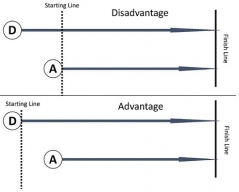Inequality: Minority disadvantage or White privilege? - And why it matters
Around the world, some groups are privileged. For instance, in the Netherlands, the Surinamese, Moluccans, Antilleans, Turks, and Moroccans are considered disadvantaged. In the United States, African Americans, Native Americans, and Latinos are considered disadvantaged.
Did you notice that I mentioned that some groups are advantaged over others, but my examples described disadvantaged ethnic minorities? I did not bend logic. Inequality is inequality. However, there are different ways to think about inequality. Indeed, alternative ways of describing inequality subtly influence what people think should be done about it.
The widely accepted framing of ethnic inequality is that it is minority disadvantage (Kluegel & Smith, 1986; Lowery & Wout, 2010; McIntosh, 2004; Powell, Branscombe, & Schmitt, 2005). Some researchers have investigated how framing inequality in terms of White Americans’ privilege or advantage changes the implications of inequality for one’s group.
 (Click to enlarge)Brian Lowery and Rosalind Chow use the following an analogy: Imagine two runners on a track, but one is behind the starting line and one is right at the line. The point at which there is equality (the starting line) is known, and it is clear that one person is behind. Here, the advantaged runner (A) is now simply where she should begin the race. That hardly sounds like privilege, right? What if we moved both runners forward such that the advantaged runner is ahead of the starting line and the disadvantage runner (D) is at the line? The disadvantaged runner is now where he should begin the race and the advantaged runner looks outright privileged.
(Click to enlarge)Brian Lowery and Rosalind Chow use the following an analogy: Imagine two runners on a track, but one is behind the starting line and one is right at the line. The point at which there is equality (the starting line) is known, and it is clear that one person is behind. Here, the advantaged runner (A) is now simply where she should begin the race. That hardly sounds like privilege, right? What if we moved both runners forward such that the advantaged runner is ahead of the starting line and the disadvantage runner (D) is at the line? The disadvantaged runner is now where he should begin the race and the advantaged runner looks outright privileged.
Brian Lowery and Daryl Wout (2010) investigated how framing inequality in terms of White advantage versus minority disadvantage plays out in the academic domain. It turns out that framing inequality in terms of White advantage has more positive consequences for minority students’ academic engagement than when framing inequality in terms of minority disadvantage. Why might this be? These researchers found that when reading about academic inequality in terms of White advantage, African Americans and Latinos reported that their sense of self was more connected to their academic performance. Feeling disadvantaged leads minorities to discount academic outcomes more strongly given that the outcomes feel biased against them. If outcomes are biased against me and my group, why would I invest myself in academic achievement? However, White advantage implies that minorities are at the starting line, so to speak, while Whites are ahead of the line. Such a frame implies that even if Whites experience favoritism in the academic domain, minorities’ outcomes are still meaningful. Framing inequality in this way turns academic achievement into a domain in which a minority student may want to develop her sense of self.
What happens when White (European American) students read about academic inequality in terms of White advantage rather than as minority disadvantage? Among Whites who highly identify with their group, exposure to the White advantage frame leads their sense of self to become less engaged with academic outcomes. Lowery and Wout (2010) take this to mean that the frame makes these Whites feel like they are, metaphorically speaking, ahead of the starting line. This, in turn, makes them less confident that their academic outcomes are deserved. A student who invests his sense of self in academic performance will desire that his outcomes reflect his aptitude rather than privilege. Thus, a White advantage frame is disengaging for Whites much in the same way that a minority disadvantage frame is disengaging for minorities.
The implications of inequality framing extend beyond the academic domain. For example, Brian Lowery, Rosalind Chow, Eric Knowles, and Miguel Unzueta (2012) studied the effects of inequality framing in a business context. In one of their experiments, White participants read about a firm with old recruiting policies that unfairly “disadvantaged Blacks” or read that they “advantaged Whites.” Participants who read about the old policies as White advantage supported a new policy that decreased White representation more than those who had read about the old policies as Black disadvantage. Thus, participants thinking of their group as advantaged approved of reducing their group’s privilege by bringing their group back toward the metaphorical starting line. This pattern of results even holds true for the wider societal situation. In another experiment, White participants who read about ethnic inequality in the U.S. as White advantage were more likely to support new governmental policies that reduce opportunities for Whites than did those who read about inequality as minority disadvantage.
Why does this matter? The predominant inequality frame in society – minority disadvantage – may discourage minorities from investing in domains in which they are considered disadvantaged. Could acknowledging inequality as White privilege reduce the attrition of minorities from science, technology, engineering, and mathematics, leading to greater minority representation in these fields? Shifting to a narrative of White privilege may even elicit Whites’ support for policies aimed at reducing their advantage. It may be the commonly used frame of minority disadvantage that enables Whites to avoid questioning the legitimacy of ethnic inequality.
If you think reducing ethnic inequality is desirable, the next time you talk about it, consider framing it as White advantage.
References:
Kluegel, J. R., & Smith, E. R. (1986). Beliefs about inequality: Americans’ views of what is and what ought to be. Hawthorne, NY: Aldine de Gruyter.
Lowery, B. S., Chow, R. M., Knowles, E. D, & Unzueta, M. M (2012). Paying for positive group-esteem: How inequity frames affect Whites’ responses to redistributive policies. Journal of Personality and Social Psychology, 102, 323-336.
Lowery, B. S., & Wout, D. (2010). When inequality matters: The effect of inequality frames on academic engagement. Journal of Personality and Social Psychology, 98, 956–966.
McIntosh, P. (2004). White privilege: Unpacking the invisible knapsack. In P. S. Rothenberg (Ed.), Race, class, and gender in the United States (pp. 188–192). New York, NY: Worth.
Powell, A. A., Branscombe, N. R., & Schmitt, M. T. (2005). Inequality as ingroup privilege or outgroup disadvantage: The impact of group focus on collective guilt and interracial attitudes. Personality and Social Psychology Bulletin, 31, 508–521.


